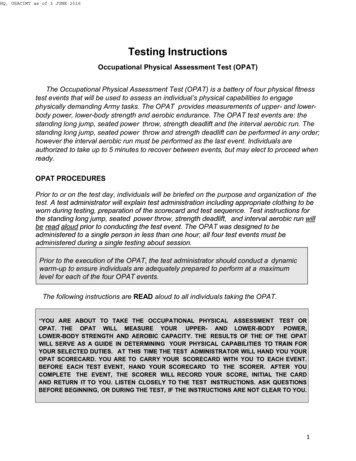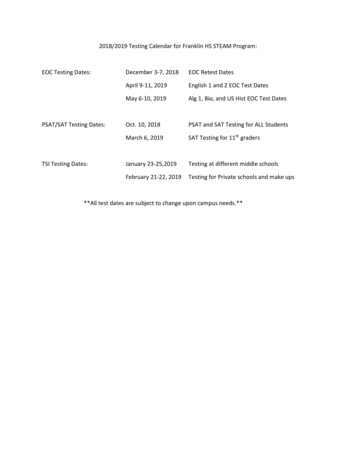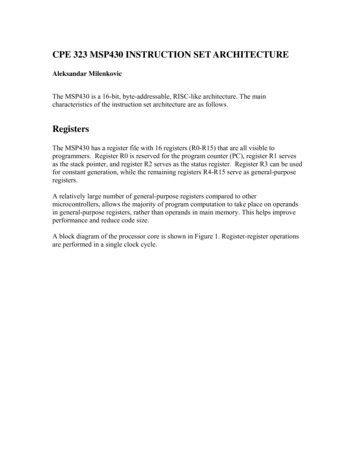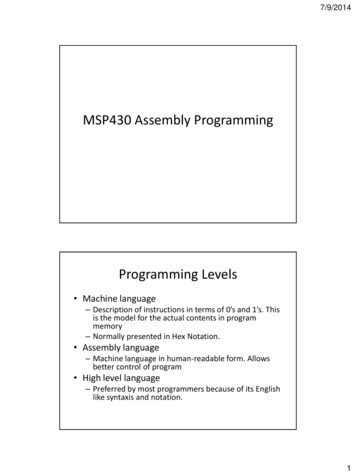
Transcription
Testing InstructionsOccupational Physical Assessment Test (OPAT)The Occupational Physical Assessment Test (OPAT) is a battery of four physical fitnesstest events that will be used to assess an individual’s physical capabilities to engagephysically demanding Army tasks. The OPAT provides measurements of upper- and lowerbody power, lower-body strength and aerobic endurance. The OPAT test events are: thestanding long jump, seated power throw, strength deadlift and the interval aerobic run. Thestanding long jump, seated power throw and strength deadlift can be performed in any order;however the interval aerobic run must be performed as the last event. Individuals areauthorized to take up to 5 minutes to recover between events, but may elect to proceed whenready.OPAT PROCEDURESPrior to or on the test day, individuals will be briefed on the purpose and organization of thetestPrior to the execution of the OPAT, the test administrator should conduct a dynamicwarm-up to ensure individuals are adequately prepared to perform at a maximumlevel for each of the four OPAT events.The following instructions are READ aloud to all individuals taking the OPAT.“YOU ARE ABOUT TO TAKE THE OCCUPATIONAL PHYSICAL ASSESSMENT TEST OROPAT. THE OPAT WILL MEASURE YOUR UPPER- AND LOWER-BODYPOWER,LOWER-BODY STRENGTH AND AEROBIC CAPACITY. THE RESULTS OF THE OF THE OPATWILL SERVE AS A GUIDE IN DETERMINING YOUR PHYSICAL CAPABILITIES. AT THIS TIME THE TEST ADMINISTRATOR WILL HAND YOU YOUROPAT SCORECARD. YOU ARE TO CARRY YOUR SCORECARD WITH YOU TO EACH EVENT.BEFORE EACH TEST EVENT, HAND YOUR SCORECARD TO THE SCORER. AFTER YOUCOMPLETE THE EVENT, THE SCORER WILL RECORD YOUR SCORE, INITIAL THE CARDAND RETURN IT TO YOU. LISTEN CLOSELY TO THE TEST INSTRUCTIONS. ASK QUESTIONSBEFORE BEGINNING, OR DURING THE TEST, IF THE INSTRUCTIONS ARE NOT CLEAR TO YOU.DO YOUR BEST O N E AC H TEST EVENT.”
Standing Long JumpSeated Power ThrowStrength DeadliftInterval Aerobic RunFigure 1. OPAT eventsSTANDING LONG JUMP INSTRUCTIONS:“THE PURPOSE OF THE STANDING LONG JUMP IS TO ASSESS LOWER- BODY POWER. YOUWILL STAND BEHIND THE TAKE-OFF LINE WITH YOUR FEET PARALLEL AND SHOULDER-WIDTHAPART. YOU WILL JUMP AS FAR AS POSSIBLE WITH A TWO-FOOT TAKE-OFF AND LANDING. YOUARE ALLOWED TO ROCK ON YOUR TOES AND HEELS, BUT YOUR FEET CANNOT BE RAISEDOFF THE G R O U N D BEFORE THE JUMP. THE JUMP BEGINS BY MOVING BOTH ARMSFORWARD AND BACKWARD (ARM COUNTER-MOVEMENTS) WHILE BENDING AT THE KNEES ANDHIPS. DO NOT MOVE YOUR FEET AFTER LANDING. AFTER LANDING IF YOU MOVE YOUR FEETYOU MAY BE ASKED TO REPEAT THE JUMP. IF YOU FALL BACKWARD YOU WILL REPEAT THEPERFOTWO SUB-MAXIMAL PRACTICE JUMPSJUMP. YOUFOLLOWED BY THREEMAXIMUM EFFORT JUMPS. THE JUMP IS SCORED TO THECLOSEST CENTIMETER FROM THE HEEL CLOSEST TO THE TAKE-OFF LINE. WATCH THISDEMONSTRATION.”Figure 2. Standing long jump
STANDING LONG JUMP CHECKPOINTS:During the execution of the standing long jump, the scorer will focus on thefollowing:1. Ensure the individual’s toes are behind the take-off line, feet are paralleland approximately shoulder-width apart.Figure 3. Standing long jump starting position2. Individuals may perform several counter-movements (swinging arms forward andbackward while bending the knees) before jumping as far forward as possible.Figure 4. Standing long jump counter movement3. Ensure individual does not take a small hop or step prior to executing thestanding long jump.Figure 5. Hop or step prior to the jump
4. ITwo Sub-maximalPractice JumpsThree Successful JumpsFigure 6. Sub-maximal practice and successful jumps5. If an individual falls forward or backward and/or moves their feet, the jump doesnot count and the jump will be repeated.Falling Forwardwith Foot MovementFalling BackwardMoving Feet Priorto ScoringFigure 7. Movements that cause the jump to be repeated6. The distance for each jump is recorded to the closest centimeter (cm) bymeasuring from the take-off line to back of the heel closest to the take-off line.Measurement is takenfrom takeoff line to theheel closest to thetakeoff line incentimeters (cm).Figure 8. Scoring the standing long jump“WHAT ARE YOUR QUESTIONS ABOUT THE STANDING LONG JUMP?”
SEATED POWER THROW INSTRUCTIONS:“THE PURPOSE OF THE SEATED POWER THROW IS TO ASSESS UPPER-BODY POWER. DURINGTHE TEST, YOU WILL SIT ON THE FLOOR WITH YOUR LOWER BACK AGAINST THE YOGA BLOCKAND UPPER BACK AGAINST THE WALL. YOUR HEAD W I LL N O T T O UCH T HE W AL L. YOURLEGS W I LL BE EXTENDED STRAIGHT OUT IN FRONT OF YOU. YOU WILL HOLD THE MEDICINEBALL WITH TWO HANDS. WHEN I SAY “GO”, BRING THE MEDICINE BALL TO YOUR CHESTWITH YOUR ELBOWS COMFORTABLY AT YOUR SIDES. YOU WILL PAUSE BRIEFLY, THENPUSH/THROW THE MEDICINE BALL UPWARDS AND OUTWARDS AT A 45 ANGLE. TO MAXIMIZETHE DISTANCE OF THE THROW, FOLLOW THROUGH BY FLEXING YOUR WRISTS. DO NOT THROWTHE MEDICINE BALL LIKE SHOOTING A BASKETBALL. THE DISTANCE OF YOUR THROW WILL BEMEASURED FROM THE WALL TO THE SPOT THE BALL LANDS. YOU WILL BE O FF ER ED TWOPRACTICE THROWS. AFTER THE PRACTICE THROWS, YOU WILL PERFORM THREE MAXIMALEFFORT THROWS. IF YOU FAIL TO MAINTAIN CONTACT WITH THE WALL, YOU WILL REPEAT THETHROW. THE THROW IS SCORED FROM THE WALL TO THE NEAREST 10 CENTIMETERS FROMWHERE THE BALL CONTACTS THE GROUND.WATCH THIS DEMONSTRATION.”Figure 9. Seated power throwSEATED POWER THROW CHECKPOINTS:During the execution of the seated power throw, the scorer will focus on thefollowing:1. Ensure the individual’s upper back maintains contact with wall and lower backwith the yoga block.Upper-back maintainscontact with the wall.Lower-back maintainscontact with the yogablock.Figure 10. Seated power throw starting position
2. The individual’s starting position should be with the arms comfortably at thesides with the ball touching the middle of the chest.Figure 11. Seated power throw starting position3. Individuals should attempt to throw the medicine ball using equal force from both arms:Correct Throwing MotionIncorrect Throwing MotionFigure 12. Seated power throwing motion“WHAT ARE YOUR QUESTIONS ABOUT THE SEATED POWER THROW?”
STRENGTH DEADLIFT INSTRUCTIONS:Figure13.Strength deadlift practice repetitions (D-handles up)Figure 14. Strength deadlift(1 repetition for 120 lbs, 140 lbs, 160 lbs, 180 lbs, 190 lbs, 200 lbs, 210 lbs, and 220 lbs.)777
STRENGTH DEADLIFT CHECKPOINTS:During the execution of the strength deadlift, the scorer will focus on the following:Starting position:1. Ensure the individual places feet shoulder-width apart inside the openspace of the bar.Figure 15. Strength deadlift foot placement2. Ensure the individual maintains knees in line with the toes.Figure 16. Strength deadlift knees in-line with toes
3. Ensure the individual bends at the hips, with hips back, so that the back is flator slightly arched.Correct DeadliftTechniqueIncorrect Deadlift TechniqueExcessive Back ArchFigure 17. Lifting technique4. Ensure the individual’s head and neck are in a neutral position with eyes facingforward (avoid rounding of the spine).Figure 18. Spine and neck alignment
Strength Deadlift Motion:1. Ensure the individual pulls the bar straight up by extending the knees and hipsin a slow, smooth and continuous movement at the same time.Figure 19. Hip and knee extension2. The individual must not allow the knees to collapse inward when lowering orraising the bar (called a "valgus collapse").Figure 20. Knee collapse3. Ensure the individual’s shoulders remain above the hips at all times.Shouldersremainabove hipsthroughoutthe lift.Figure 21. Shoulders above hips
4. Ensure the individual’s heels maintain contact with the ground throughout the lift.Heels in contact with groundHeels not in contact with groundFigure 22. Heels in contact with ground5. Lateral or uneven foot placement during the lift.Figure 23. Lateral or uneven foot placement“WHAT ARE YOUR QUESTIONS ABOUT THE STRENGTH DEADLIFT?”
INTERVAL AEROBIC RUN INSTRUCTIONS:“THE PURPOSE OF THE INTERVAL AEROBIC RUN IS TO ASSESS AEROBIC CAPACITY. T HISTEST INVO L VE S R U NNING BET W EEN TWO D E S I G N AT E D P O INTS THAT ARE 20M ET ERS AP ART. THE RUNNI NG PACE IS S Y N C H RO N I Z E D WITH “B E EP S” ATSP ECIFIC INT E RV ALS . AS THE TEST P R O G R E S S E S , THE TIM E BET W EEN “BEEPS”GETS SHO RT ER, REQUIRING YOU TO RUN F AST ER. YOU WILL STAND BEHIND THESTARTING LINE FACING THE SECOND LINE 20 METERS AWAY. THE TEST STARTS WITH A 5SECOND COUNTDOWN AND 3 “BEEPS”. AT THE “B E EP” YOU WILL S L O W L Y JOG BETWEENTHE TWO LINES. YOU SHOULD TOUCH THE OPPOSITE LINE SHORTLY BEFORE THE NEXT“BEEP”. IF YOU “ARRIVE” EARLY, CONTINUE ACROSS THE LINE, TURN AROUND AND WAITFOR THE “BEEP”. AFTER ABOUT ONE MINUTE, THE SPEED WILL INCREASE TO THE NEXTLEVEL AS INDICATED BY A “BEEP-BEEP-BEEP”. THE “BEEPS” WILL N O W BE CLOSERTOGETHER AND YOU MUST RUN FASTER. IF YOU DO NOT TOUCH THE LINE BEFORE THE“BEEP”, YOU WILL BE GIVEN A WARNING (EXAMPLE: “WARNING #1”; “WARNING #2”). IF YOUFAIL TO TOUCH THE 20-METER LINE BEFORE THE “BEEP” THREE TIMES IN A ROW,YOU WILL BE TOLD TO STOP. IF YOU FAIL TO REACH THE LINE ONE OR TWO TIMES IN AROW, AND THEN SUCCESSFULLY REACH THE LINE BEFORE THE BEEP, THE COUNT FORWARNINGS WILL START OVER. W ATCH THIS DEM ONSTRATION.”2Meters20 MetersFigure 24. Interval aerobic run lane“WHAT ARE YOUR QUESTIONS ABOUT THE INTERVAL AEROBIC RUN?”
5. If an individual falls forward or backward and/or moves their feet, the jump does not count and the jump will be repeated. Falling Forward Falling Backward Moving Feet Prior with Foot Movement to Scoring Figure 7. Movements that cause the jump to be repeated 6. The distance for each ju











